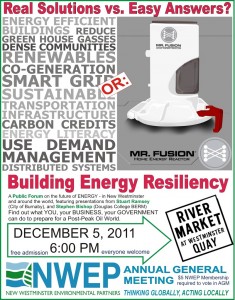I have a real love-hate thing going on with the Planning Department in New Westminster. Well, “hate” is too strong a word; let’s call it love-like somewhat less.
During the recent election, I noted the incredible progress the City has made over the last decade. The Downtown, 12 Street, Sapperton, the waterfront trails in Queensborough: there is a lot of great stuff going on. During the election, I mostly gave the kudos to the politicians running the place, but equal (or greater?) credit has to go to the planners in the City who help bring the visions of multiple parties (developers, council, neighbourhoods, third party stakeholders, rabble-rousers) together into what will hopefully be the best possible compromise to move the City forward.
The revitalization of the Downtown is ongoing and already showing significant dividends. As I mentioned last year, the building of the MUCF at 8th and Columbia will be an important piece in this puzzle, as will the opening of the retail spaces at the New Westminster Station, the date of which was just announced. However, I remain highly critical of how the pedestrian experience of this keystone entrance to our new Downtown is being managed. Today, the City will officially decide to shut down the 8th Street crosswalk that is so heavily used (and would continue to be used as the preferable pedestrian route to the MUCF), its timing not exactly coincident with the building of alternative routes, but with the need to accommodate a staging area for the Santa Claus Parade. Alas.
What concerns me more, though, is that the City is finally making public announcements about what has been rumoured for the last year or two: they want someone to build a hotel on the Kyoto block, the recently-demolished set of buildings on the north-west corner of 8th and Columbia, immediately adjacent the entrance escalator to the New Westminster Station.
Potentially sticking another big pedestrian roadblock at the entrance to our downtown, and turning over what could be a precious piece of public open space – one that belongs to the City – into another high-rise development.
Back when I was winging about how the MUCF essentially turned it’s back on 8th Street and the Skytrain Station, my main complaint was one of potential lost opportunity. With Plaza 88 bringing people into New Westminster to go to the new theatres, there is a great opportunity to draw those people onto Columbia for the new eating, drinking and shopping opportunities that are being developed there. Tying these to the River Market via an upgraded pedestrian overpass behind Hyack square would be a bonus.
Now that 8th Street will be inevitably lost as pedestrian space, the question remains how we will draw people to Columbia Street. The answer seems to be down a shadowy narrow escalator, past a couple of loading bays in the shadow of big buildings. We can do better.
Imagine Kyoto Plaza (actually imagine a better name, but stay with me here…), an 6000-square foot open space across Columbia Street from similar-sized Hyack Square. To the west is the concrete wall of the Plaza 88 Theatres, adorned with green and/or water features, and cut by a curving, pedestrian ramp carrying people down from the New West Station concourse, giving them a grand view of the streetscape below and to the east. In the centre of the plaza sloping up to the ramp are planters, seating areas, maybe even a fountain, to compliment the architecture of Hyack Square across the street. The intersection of 8th and Columbia will be wide, and slightly elevated, perhaps in the “pedestrian scramble” design, to link together open spaces north and south, and to provide a visual entrance to Columbia Street for cars approaching from the east.
Let’s give people a reason to step out of Plaza 88, and at first look towards Columbia Street, then go down there and spend some money. Let’s give the office workers and visitors of the new MUCF an open space to sit, soak up sun, eat lunch. Let’s give people walking from other neighbourhoods, people arriving by car or by Skytrain a place to meet up before going for a drink, for dinner, or for a movie.
Let people’s first impression of the Royal City when they get off the SkyTrain be of an open, happening, safe and comfortable place with lots to offer, instead of a dark tunnel-like walking route past parking garage entrances and high-rises.
Come to think of it, we can even support the Downtown BIA’s never-satiated hunger for more parking by providing 3 floors of underground parking, similar to the MUCF, and add 150 spots to the downtown inventory (or maybe 200 if we link to the MUCF using the area under 8th Street), while still keeping the ground level as human, pedestrian space.
I have nothing against hotels, and recognize it is an asset the City could use more of. I doubt whether this is the best space for it. There are lots of 6500-square foot footprints in downtown where an interested business can stick a boutique hotel, there are very few open spaces that are in the possession of the City and serve as the entrance to our Downtown for visitors arriving by car and by transit, and as a link between our main shopping street, our eponymous Transit Centre, and our Waterfront Market. We have an opportunity to alleviate the unfortunate loss of pedestrian space around the MUCF with some visionary planning right now, and benefit the entire downtown retail area with some creative land use decisions here. Let’s not lose this second chance.
C’mon Planning Department, Make me love you again…



